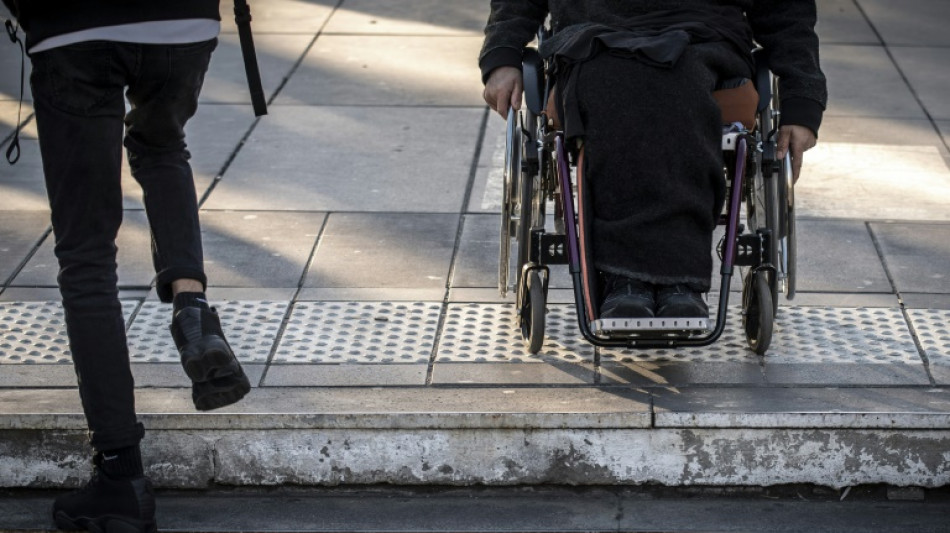
-
 Asia markets fluctuate as investors mull Trump-Xi talks
Asia markets fluctuate as investors mull Trump-Xi talks
-
Trump, Xi ease fight on tariffs, rare earths

-
 Volkswagen posts 1-billion-euro loss on tariffs, Porsche woes
Volkswagen posts 1-billion-euro loss on tariffs, Porsche woes
-
'Fight fire with fire': California mulls skewing electoral map

-
 Fentanyl, beans and Ukraine: Trump hails 'success' in talks with Xi
Fentanyl, beans and Ukraine: Trump hails 'success' in talks with Xi
-
'Nowhere to sleep': Melissa upends life for Jamaicans
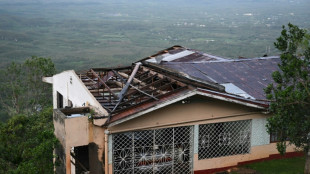
-
 Irish octogenarian enjoys new lease on life making harps
Irish octogenarian enjoys new lease on life making harps
-
Tanzania blackout after election chaos, deaths feared

-
 G7 meets on countering China's critical mineral dominance
G7 meets on countering China's critical mineral dominance
-
Trump hails tariff, rare earth deal with Xi

-
 Court rules against K-pop group NewJeans in label dispute
Court rules against K-pop group NewJeans in label dispute
-
India's Iyer says 'getting better by the day' after lacerated spleen

-
 Yesavage fairytale carries Blue Jays to World Series brink
Yesavage fairytale carries Blue Jays to World Series brink
-
Bank of Japan keeps interest rates unchanged

-
 Impoverished Filipinos forge a life among the tombstones
Impoverished Filipinos forge a life among the tombstones
-
Jokic posts fourth straight triple-double as Nuggets rout Pelicans

-
 UN calls for end to Sudan siege after mass hospital killings
UN calls for end to Sudan siege after mass hospital killings
-
Teenage Australian cricketer dies after being hit by ball

-
 As Russia advances on Kupiansk, Ukrainians fear second occupation
As Russia advances on Kupiansk, Ukrainians fear second occupation
-
Trade truce in balance as Trump meets 'tough negotiator' Xi

-
 China to send youngest astronaut, mice on space mission this week
China to send youngest astronaut, mice on space mission this week
-
Yesavage gem carries Blue Jays to brink of World Series as Dodgers downed

-
 With inflation under control, ECB to hold rates steady again
With inflation under control, ECB to hold rates steady again
-
Asia stocks muted with all eyes on Trump-Xi meeting

-
 Personal tipping points: Four people share their climate journeys
Personal tipping points: Four people share their climate journeys
-
Moto3 rider Dettwiler 'no longer critical' after crash: family

-
 US economy in the dark as government shutdown cuts off crucial data
US economy in the dark as government shutdown cuts off crucial data
-
Trump orders nuclear testing resumption ahead of Xi talks
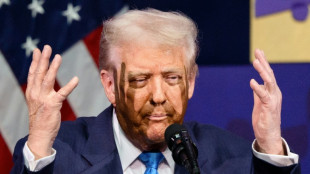
-
 'Utter madness': NZ farmers agree dairy sale to French group
'Utter madness': NZ farmers agree dairy sale to French group
-
Samsung posts 32% profit rise on-year in third quarter

-
 30 years after cliffhanger vote, Quebec separatists voice hope for independence
30 years after cliffhanger vote, Quebec separatists voice hope for independence
-
Taxes, labor laws, pensions: what Milei wants to do next

-
 South Sudan's blind football team dreams of Paralympic glory
South Sudan's blind football team dreams of Paralympic glory
-
US says 4 killed in new strike on alleged Pacific drug boat
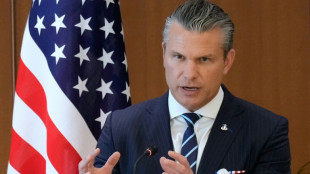
-
 What we do and don't know about Rio's deadly police raid
What we do and don't know about Rio's deadly police raid
-
'They slit my son's throat' says mother of teen killed in Rio police raid

-
 Arteta hails 'special' Dowman after 15-year-old makes historic Arsenal start
Arteta hails 'special' Dowman after 15-year-old makes historic Arsenal start
-
Google parent Alphabet posts first $100 bn quarter as AI fuels growth

-
 Underwater 'human habitat' aims to allow researchers to make weeklong dives
Underwater 'human habitat' aims to allow researchers to make weeklong dives
-
Maresca slams Delap for 'stupid' red card in Chelsea win at Wolves

-
 'Non-interventionist' Trump flexes muscles in Latin America
'Non-interventionist' Trump flexes muscles in Latin America
-
Slot defends League Cup selection despite not meeting 'Liverpool standards'

-
 'Poor' PSG retain Ligue 1 lead despite stalemate and Doue injury
'Poor' PSG retain Ligue 1 lead despite stalemate and Doue injury
-
Liverpool crisis mounts after League Cup exit against Palace

-
 Kane scores twice as Bayern set European wins record
Kane scores twice as Bayern set European wins record
-
Radio Free Asia suspends operations after Trump cuts and shutdown
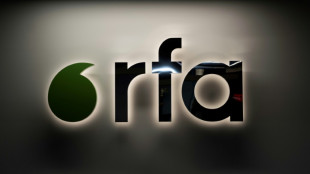
-
 Meta shares sink as $16 bn US tax charge tanks profit
Meta shares sink as $16 bn US tax charge tanks profit
-
Dollar rises after Fed chair says December rate cut not a given

-
 Google parent Alphabet posts first $100 bn quarter as AI drives growth
Google parent Alphabet posts first $100 bn quarter as AI drives growth
-
Rob Jetten: ex-athlete setting the pace in Dutch politics


Spinal cord implant helps paralysed patients walk again
In 2017, Michel Roccati was in a motorbike accident that left his lower body completely paralysed. In 2020, he walked again, thanks to a breakthrough new spinal cord implant.
The implant sends electrical pulses to his muscles, mimicking the action of the brain, and could one day help people with severe spinal injuries stand, walk and exercise.
It builds on long-running research using electrical pulses to improve the quality of life for people with spinal cord injuries, including a 2018 study by the same team that helped people with partial lower-body paralysis walk again.
"It was a very emotional experience," Roccati told journalists of the first time the electrical pulses were activated and he took a step.
He was one of three patients involved in the study, published Monday in the journal Nature Medicine, all of them unable to move their lower bodies after accidents.
The three were able to take steps shortly after the six-centimetre implant was inserted and its pulses were fine-tuned.
"These electrodes were longer and larger than the ones we had previously implanted, and we could access more muscles thanks to this new technology," said Jocelyne Bloch, a neurosurgeon at the Lausanne University Hospital who helped lead the trial.
Those initial steps, while breathtaking for the researchers and their patients, were difficult and required support bars and significant upper body strength.
But the patients could start rehabilitation immediately, and within four months Roccati could walk with only a frame for balance.
"It's not that it's a miracle right away, not by far," cautioned Gregoire Courtine, a neuroscientist at the Swiss Federal Institute of Technology who led the research with Bloch.
But with practice, Roccati can now stand for several hours and walk nearly a kilometre. The Italian described being able to look clients in the eye, have a drink at a standing table and take a shower standing up thanks to the implant.
He and others in the trial were also able to climb stairs, swim and canoe.
- 'I see the improvement' -
The improvements depend on the electrical stimulation, which is triggered via a computer carried by the patient that activates a pattern of pulses.
Two of the patients can now activate their muscles slightly without electrical pulses, but only minimally.
By comparison, some patients with partial lower body paralysis treated in an earlier study are able to move their previously immobile legs and stand without stimulation.
The three men in the new trial were all injured at least a year before the implant and Bloch hopes to trial the technology sooner after an accident.
"What we all think is that if you try earlier it will have more effect," she said.
There are challenges: in early recovery, a patient's capacity is still in flux, making it hard to set a baseline from which to measure progress, and ongoing medical treatment and pain could hamper rehabilitation.
So far, the implants are also only suitable for those with an injury above the lower thoracic spinal cord, the section running from the base of the neck to the abdomen, because six centimetres of healthy spinal cord is needed.
The idea of using electrical pulses to address paralysis stemmed from technology used to regulate pain, and the researchers said they see scope for further applications.
They have also shown it can regulate low blood pressure in spinal cord injury patients and plan to soon release a study on its use for severe Parkinson's disease.
The team cautioned that significant work remains before the implant is available for treatment outside clinical studies, but said they receive around five messages a day from patients seeking help.
They next plan to miniaturise the computer controlling the pulses so it can be implanted in patients and controlled with a smartphone.
They expect this to be possible this year, and have plans for large-scale trials involving 50-100 patients in the United States and then Europe.
Roccati said he activates the implant daily at home and continues to get stronger.
"I see the improvement every day," he said.
"I feel better when I use it."
D.Schneider--BTB




